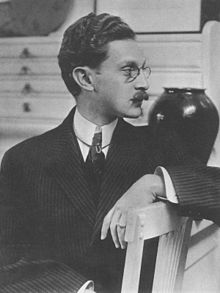Morton Livingston Schamberg
Morton Livingston Schamberg (born October 15, 1881 in Philadelphia , United States, † October 13, 1918 there ) was an American painter. He was one of the first in the United States to take up cubism and thus found access to abstract painting . Possibly he was the first in art history to paint machine parts.
life and work
The family was of German-Jewish origin; the father had made his money in the cattle trade. The Schambergs lived on Broad Street, a top address in Philadelphia at the time. Morton was the youngest of four siblings; his mother had died when he was an infant. The siblings grew up with relatives. Morton attended Central High School , then one of the premier schools in Philadelphia.
In 1899 he enrolled at the University of Pennsylvania in the Faculty of Fine Arts and graduated in 1903 with a bachelor's degree in architecture. During his studies, however, he must have realized that he was unsuitable for a career in architecture. He immediately moved to the Academy of Fine Arts ( Pennsylvania Academy of the Fine Arts ). Here he met Charles W. Sheeler , with whom he would have a lifelong friendship. One teacher in particular, William Merritt Chase , recognized and promoted his talent. At Chase, Schamberg learned to apply the paint directly with a brush in a paste-like manner to the canvas without preliminary drawing. As unusual as this technique was for academy standards, nothing in its style indicates that Schamberg would later break out of conventions.

After graduating in 1906, Schamberg went to Paris for a year. Upon his return, he and his friend Sheeler rented a studio on Chestnut Street. In 1908 they both traveled to Europe together. In 1908/09 Schamberg must also have visited the Uffizi Gallery in Florence and Siena.
Schamberg could not live off his painting and therefore opened a photo studio in 1913. In the same year he began to split up portraits of women and then landscapes into small facets, later calling his abstract paintings only “geometric shapes”. Surprisingly, he received the invitation to exhibit at the now legendary Armory Show in New York. Five of his paintings were shown here. In 1914 he was represented in a group exhibition in New York, and in 1915 in Philadelphia. It was the first time that “modern” art was shown in this city.
Morton Schamberg was cautious in character, only when it came to questions of art could he become lively and vehement. His turn to abstract painting was received with astonishment by his family and art lovers. His art school teacher, William Chase, never spoke to him again after seeing Schamberg's first abstract painting. During the First World War, Schamberg was shocked by the mass deaths and declared himself an opponent of the war. He also made publicly pro-German statements, which additionally isolated him.

From 1916 onwards Schamberg painted several "mechanical abstractions". Occasionally the devices are still recognizable as telephones or the flash of a camera, but soon they will only become abstract “machine forms”. Maybe he had got the suggestion from catalogs for machine parts that he had borrowed from his brother-in-law. Schamberg was friends with Marcel Duchamp . In the style of Duchamp's ready mades , he and Elsa von Freytag-Loringhoven constructed an object from drainpipes as early as 1916, which was entitled God! wore.
At first, Schamberg was perceived by his contemporaries as a "post-impressionist". He himself appealed to Cézanne, Matisse and Picasso. Few critics recognized that Schamberg's style pointed to the future, including Henry McBride , as well as his former fellow student at the art academy, Walter Pach . The first collectors to acquire works during his lifetime were John Quinn and Walter Arensberg . Schamberg was later attributed to Precisionism , in his case because of the use of geometric shapes.
Schamberg died in 1918 at the age of only 37. So he was no longer able to see his first solo exhibition at Knoedler's in New York. His early death and the fact that most of his works are in private collections prevented him from becoming better known. In 1963 his work was exhibited at the Pennsylvania Academy of the Fine Arts ; A catalog was also published on the occasion.
literature
- Ben Wolf: Morton Livingston Schamberg . University of Philadelphia Press, Philadelphia 1963.
Web links
Individual proof
| personal data | |
|---|---|
| SURNAME | Schamberg, Morton Livingston |
| ALTERNATIVE NAMES | Schamberg, Morton L. |
| BRIEF DESCRIPTION | American painter |
| DATE OF BIRTH | October 15, 1881 |
| PLACE OF BIRTH | Philadelphia , United States |
| DATE OF DEATH | October 13, 1918 |
| Place of death | Philadelphia , United States |

